A little about Alhambra’s history: context for your visit
Granada claims its place on the global stage, renowned for the captivating Moorish masterpiece—the Alhambra. Attracting visitors worldwide with its mesmerizing beauty and rich history, this architectural gem signifies the deep connection between Granada and Moorish culture.
Built in the 1200s by the visionary founder of the Nasrid dynasty, a Muslim king who once governed the region, the Alhambra is a living canvas that beautifully weaves together Islamic and Christian influences.This fusion contributes to the vibrant cultural tapestry that defines Spain, earning the Alhambra its well-deserved recognition as a UNESCO World Heritage site.
Crafted from exquisite red stone, the name “Alhambra” echoes in Arabic – al-qala’a al-hamra – translating to ‘the red castle.’ As daylight dances upon the palace, the hues shift and evolve, creating a breathtaking spectacle. To fully appreciate this transformation, we recommend enjoying a drink in Albaicín, the historic Muslim quarter dating back to the 11th century, during sunset. Here, you can witness the Alhambra gracefully transitioning into a magical shade of pink.
Situated against the breathtaking backdrop of the Sierra Nevada mountains, the Alhambra unfolds a narrative that transcends time. It commenced as a formidable fortress in the 9th century, a simple structure that would undergo a remarkable metamorphosis into an epitome of Moorish architecture.
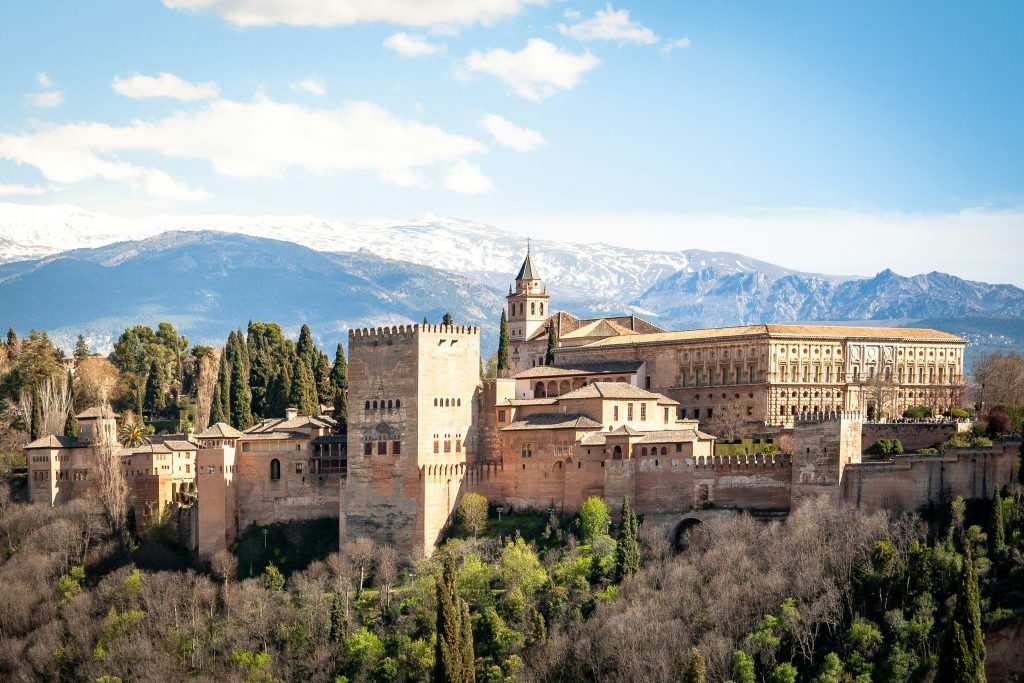
Christian Reconquista
Following Granada’s fall in 1492, the Alhambra underwent a transition under the rule of the Catholic Monarchs, marked notably by the addition of the Palace of Charles V. Despite facing periods of neglect and partial destruction, diligent restoration efforts have preserved the Alhambra as one of the world’s best-preserved medieval Islamic palaces.
The Alhambra, a palatial fortress gracing Granada’s skyline, comprises diverse sections, each bearing a unique testimony to its storied past. The Nasrid Palaces stand out for their intricate Islamic art, among the finest in Europe. The Alcazaba serves as a testament to military might, while the Generalife, once a haven for Nasrid rulers, unfolds as a serene retreat within the fortress walls. The complex also houses the Medina, remnants of a once-thriving city encapsulated within these historic walls.
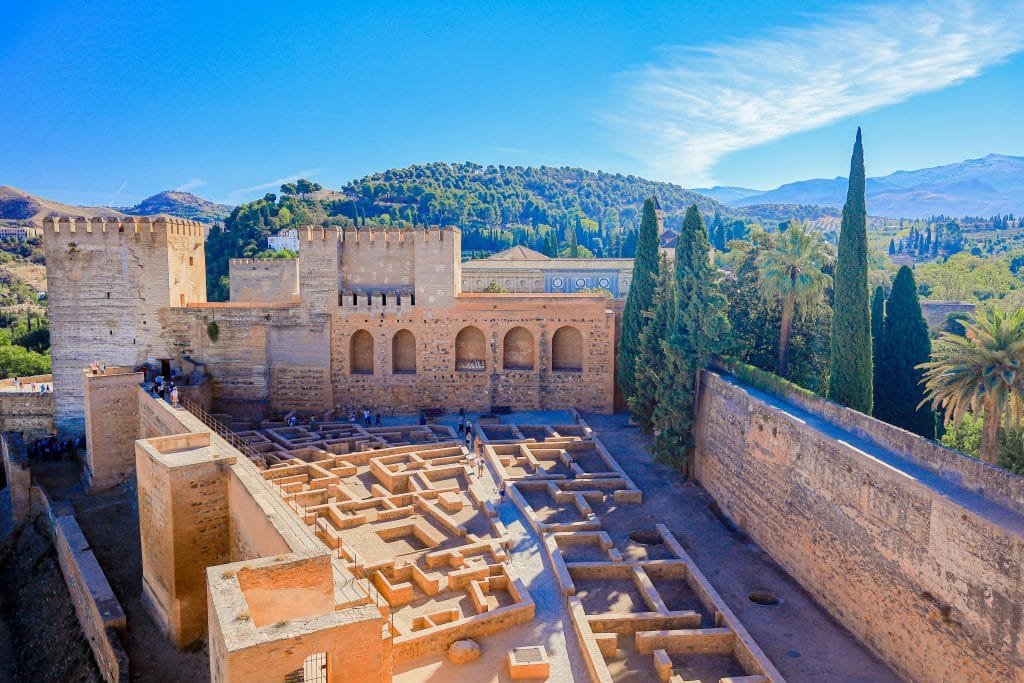
Why is the Alhambra so Significant?
As you step into the Alhambra, you are transported to an era where the Nasrid Dynasty left an indelible mark on the Iberian Peninsula. The intricate architectural details, geometric patterns, calligraphy, and exquisite tilework showcase the height of Moorish craftsmanship. Beyond its artistic allure, the Alhambra holds historical significance, having served as a royal palace, military fortress, and a symbol of power and prestige.
Diving deeper into its narrative, the Alhambra tells the story of Spain’s rich cultural blend, woven with both Islamic and Christian influences. It proudly stood as the final Moorish bastion in Europe, witnessing a critical moment when it yielded to the Catholic Monarchs, Ferdinand and Isabella. This marked the decisive end of the Reconquista and the dawn of Spain as a united, Catholic nation.
Acknowledged as a UNESCO World Heritage site, the Alhambra unfolds a captivating panorama of Islamic art and architecture seamlessly blending with subsequent Christian influences.
In essence, the Alhambra is not just a monument frozen in time; it is a living legacy, a testament to the rich tapestry of cultures, religions, and historical epochs that converge within its walls. It remains a must-see destination for aficionados of history, art, and architecture, offering an immersive journey through the ages of time.
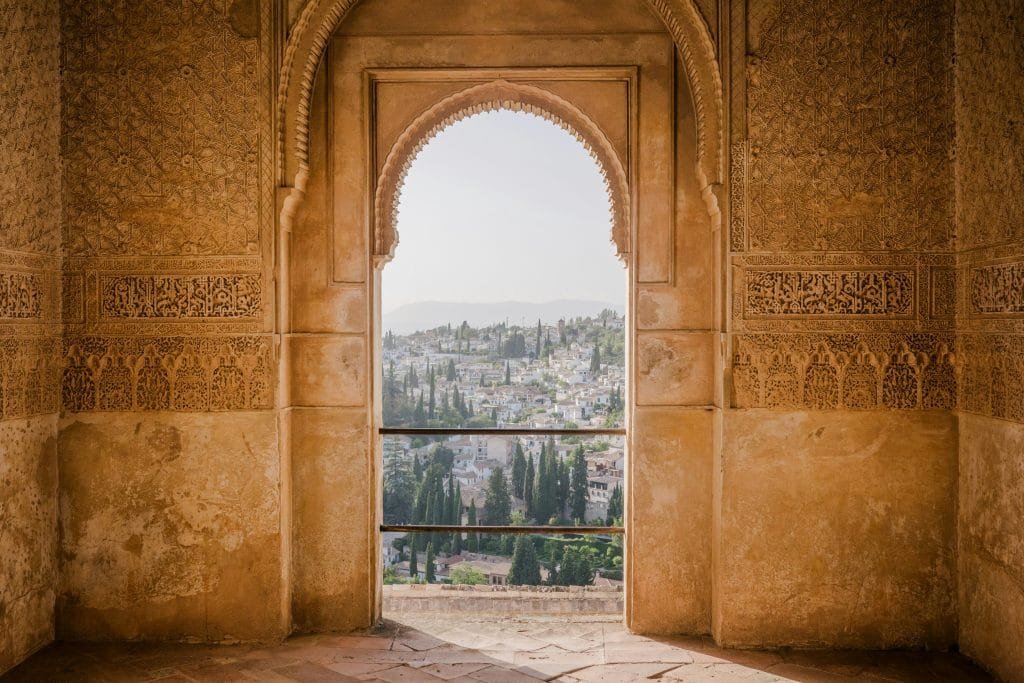
Visiting the Alhambra
Once you step into the palace, prepare to be amazed by incredible courtyards with fountains, orange trees, and stunning tilework. Everywhere you look, the stone and wood boast incredible carvings with details that boggle the mind, considering the time it took to create them! Thanks to its extraordinary history, the Alhambra has earned the prestigious title of a UNESCO World Heritage Site, making it a must-visit attraction in Granada, Spain.
Venturing outside, you’ll find magical gardens meticulously curated and home to some of the most beautiful flowers and plants. What sets these gardens apart is not just their beauty but also the breathtaking views they offer of the Andalusian landscapes and the city of Granada. It’s a visual feast that adds another layer of wonder to your Alhambra experience.
Opening Times
The Alhambra welcomes visitors every day, except on Christmas and New Year’s Day. Opening times are from 8:30 AM to 6 PM (during autumn and winter season) and from 08.30 AM to 8 PM (during spring and summer season). If you’re up for a unique experience, consider a night tour on selected evenings. Keep in mind when Alhambra shuts its doors, so plan to enter a few hours earlier to make the most of your visit.
Getting Tickets for the Alhambra:
To embark on your Alhambra adventure, grab your tickets, priced at 19.09 EUR for adults for a complete self-guided visit. For detailed information on ticket prices for minors, seniors, and other categories, refer to the FAQs section.
It’s essential to pre-book your tickets online before you arrive to secure your spot. For a more serene experience, aim to arrive after lunch for a quieter experience, as most tours would have wrapped up, resulting in fewer crowds.
Visit options:
1. If you prefer exploring at your own pace, we suggest renting an audioguide, available at the kiosk situated near the entrance to the Nasrid Palaces (view options here). This addition can significantly enhance your overall visit. Alternatively, you can access the complimentary audio guide by scanning the QR code on-site or using this link on your phone.
2. For those visiting the Alhambra for the first-time and are eager to dive deep into the intricate history of Alhambra – consider booking a guided tour. It’s an excellent way to unravel the layers of this historical gem with the guidance of an expert. These tours typically come with the added benefit of guaranteed entry to the Nasrid Palaces.
What to See in the Alhambra and How Long it Takes:
The Alhambra unfolds as a vast complex, each corner revealing a new facet of its beauty. To fully appreciate this architectural gem, allocate a minimum of half a day to your exploration. Here are the four main highlights you wouldn’t want to miss within the Alhambra:
– Generalife gardens
– Alcazaba fortress
– Charles V Palace
– The Nasrid Palaces (the star attraction)
Each spot offers a unique experience, so make sure to plan your visit accordingly to make the most of your time. Navigating the Alhambra is an adventure in itself, given its expansive size and attractions scattered across a large area. To give you a sense of the layout, it takes approximately 20 minutes to walk from the main entrance to the Generalife gardens. Keep in mind that you’ll need to retrace your steps for another 30 minutes to reach the other palaces – and that’s not counting the time spent exploring each site and waiting in potentially long lines.
Consider exploring the map of the Alhambra to enhance your understanding of this remarkable site. You can access it here.
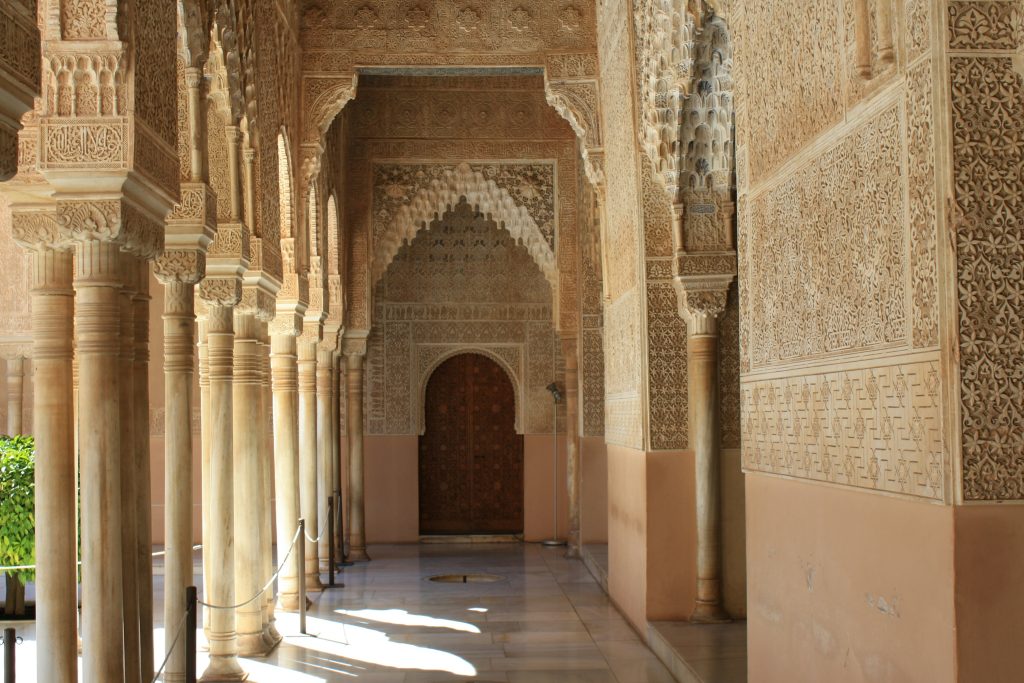
When you approach the Nasrid Palaces, you might notice a long line. Don’t worry; it tends to move quite swiftly. The Nasrid Palaces, with their intricate stucco decorations and mesmerizing courtyards like the Court of the Lions, are the heart of the Alhambra and warrant ample time for contemplation. Marvel at the intricacies of the Court of the Lions, where a fountain stands as a symbol of balance and harmony. Each room whispers stories of rulers past, with breathtaking views of Granada as a backdrop.
The Alcazaba, a fortress perched on a hill, provides panoramic views of Granada and serves as a reminder of Alhambra’s military past. As you wander through the Palacio de Carlos V, a Renaissance masterpiece within the complex, marvel at the fusion of architectural styles that add yet another layer to the Alhambra’s allure.
The Generalife Gardens, a lush retreat of fountains, terraces, and greenery, offer a serene escape from the grandeur of the palaces. Here, the Nasrid rulers found solace, and you can too, surrounded by the beauty of nature and exquisite architecture.
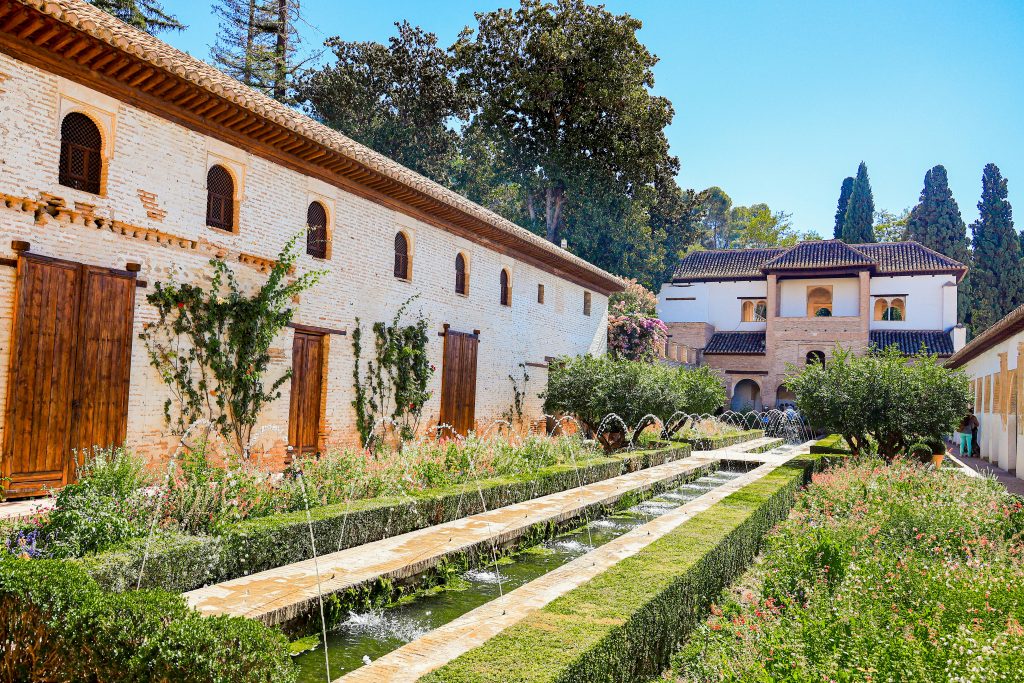
Conclusion
A visit to the Alhambra is a captivating journey through centuries of history, art, and culture. The intricate details, the awe-inspiring architecture, and the serene gardens create an experience that is both enriching and mesmerizing. Allow yourself to be transported back in time as you explore the Alhambra – a testament to the enduring beauty of Spain’s cultural heritage.
By visiting the Alhambra, you’ll experience Islamic architecture at its best, awe-inspiring views of the Sierra Nevada Mountains and the rolling hills of the Andalusian countryside.
Get your tickets early, so you don’t have to wait in line and can enjoy everything at your own pace.
Visiting the Alhambra – your questions answered
You can explore the main highlights in about 3-4 hours. However, for a more in-depth experience, allowing around 6 hours (including a lunch break) is recommended to thoroughly soak in the history and explore every detail of this magnificent site.
Depending on your ticket type, you’ll have access in the morning, afternoon, or night.
Arrive at least 45 minutes before your scheduled visit. The walk from the main gate to the Nasrid Palaces takes about 20 minutes, and being late may result in entry denial.
The best time to visit Alhambra is in late spring or summer. This ensures you can fully enjoy the beautiful gardens. However, keep in mind that this is the high season with more visitors.
Morning or Afternoon visit to Alhambra?
If you’re an early bird, early mornings when the doors open are fantastic – fewer crowds and a chance to explore everything. But, if you prefer afternoons, after lunch around 3-4pm is a sweet spot to avoid the rush and crowds. Consider booking the Nasrid Palaces for later; it’s a smart move.
Nigh visits are also an option due to the special lighting creating a magical experience in the silence of the night.
Getting to Granada is convenient, especially if you’re traveling from popular southern Spanish cities like Málaga, Seville, or Córdoba.
Transport options:
– Trains are a fantastic and reliable option. Enjoy scenic Andalusian landscapes with olive groves and rolling hills during your journey. The train station is approximately 2 km from the city center, and you can easily reach it by grabbing a taxi or taking a local bus.
– If you enjoy the freedom of driving, you can rent a car. The well-maintained roads between major cities in Andalusia provide a smooth driving experience. However, be mindful of parking in Granada; it’s recommended to plan your parking in advance to avoid potential high fees.
In theory, yes, but getting tickets for the main attraction, Nasrid Palaces, is challenging. Due to high demand, it’s advised to book at least a month in advance to secure your preferred time, tickets are capped at a certain amount daily.
Yes, you can visit without a guide. However, small-group tours are recommended if you prefer guided experiences.
Tours are great for seeing highlights and learning history, but they may move quickly. If choosing a guided tour, opt for a private or small-group tour with ample time (around 3 hours) to fully appreciate the beauty of Alhambra.
Tickets are specific to each individual and cannot be transferred. It is mandatory for every visitor to carry their own ticket throughout the entire visit.
Certainly, the Alhambra car park offers a total of 360 parking spaces, ensuring a secure environment. The parking facility is divided into four areas, one specifically designated for buses and caravans. Visitors can conveniently utilize these parking spaces while exploring the Alhambra.
Children aged 3 to 11 can acquire tickets at 0.00 €/person, but it’s essential to reserve them at the time of purchase along with the adult tickets. For purchases involving more than 3 minors, you need to contact Alhambra’s call center at +34 858 889 002 or via live chat, adults included.
Children aged 0 a 2: their tickets will be provided directly at the ticket office of the monument.
Adult – 19.09 € /person
Minors aged 12-15 – 12.73 € /person
Large family members (with card issued in Spain) – 12.73 € /person
EU Citizens over 65 – 12.73 € /person
European Youth Card Holders – 12.73 € /person
People with disabilities equal to or over 33% – 12.73 € /person
Prior to access, discount ticket holders must prove the right to the reduction in price at the ticket office.
Disclosure: All listings featured on TAO LIVIN’ are independently selected by our editors. If you click through and book something through our links, we may earn a commission at no extra cost to you. Thanks for your support!
Categories
Recent Posts
- How to Get to Marbella from Malaga Airport: Your Ultimate Travel Guide

- Parking in Marbella Old Town: Exploring the Best Places to Park

- Specialty Coffee in Marbella: 5 Must-Visit Spots for Coffee Lovers

- Fuengirola to Caminito del Rey Day Trip: The Best Ways to Experience This Iconic Hike

- Halloween in Marbella 2024: Celebrate with Fun Events and Activities





